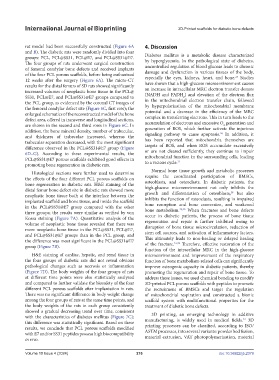Page 224 - IJB-10-4
P. 224
International Journal of Bioprinting 3D-Printed scaffolds for diabetic bone defects
rat model had been successfully constructed (Figure 6A 4. Discussion
and B). The diabetic rats were randomly divided into four Diabetes mellitus is a metabolic disease characterized
groups: PCL, PCL@SS31, PCL@E7, and PCL@SS31@E7. by hyperglycemia. In the pathological state of diabetes,
The four groups of rats underwent surgical construction uncontrolled regulation of blood glucose leads to chronic
of femoral condylar bone defects and received implants damage and dysfunction in various tissues of the body,
of the four PCL porous scaffolds, before being euthanized especially the eyes, kidneys, heart, and bone. Studies
25
12 weeks after the surgery (Figure 6A). The micro-CT have shown that a high-glucose microenvironment causes
results for the distal femurs of SD rats showed significantly an increase in intracellular MRC electron transfer donors
increased volumes of neoplastic bone tissue in the PCL@ (NADH and FADH ) and elevation of the electron flux
SS31, PCL@E7, and PCL@SS31@E7 groups compared to in the mitochondrial electron transfer chain, followed
2
the PCL group, as evidenced by the coronal CT images of by hyperpolarization of the mitochondrial membrane
the femoral condylar defect site (Figure 6C, first row); the potential and a decrease in the efficiency of the MRC
enlarged schematics of the reconstructed model of the bone complex in transferring electrons. This in turn leads to the
defect area, offered in transverse and longitudinal sections, accumulation of electrons and excessive O generation and
are shown in the second and third rows in Figure 6C. In generation of ROS, which further activate the injurious
2
addition, the bone mineral density, number of trabeculae, signaling pathway to cause apoptosis. In addition, it
26
and thickness of trabeculae increased, whereas the has been reported that mitochondria themselves are
trabecular separation decreased, with the most significant targets of ROS, and when ROS accumulate excessively
difference observed in the PCL@SS31@E7 group (Figure or are not cleared sufficiently, they continue to impair
6D–G). According to these experimental results, the mitochondrial function in the surrounding cells, leading
PCL@SS31@E7 porous scaffolds exhibited good effects in to a vicious cycle. 27
promoting bone regeneration in diabetic rats.
Histological sections were further used to determine Normal bone tissue growth and metabolic processes
the effects of the four different PCL porous scaffolds on require the coordinated participation of BMSCs,
bone regeneration in diabetic rats. H&E staining of the osteoblasts, and osteoclasts. In diabetic patients, the
distal femur bone defect site in diabetic rats showed more high-glucose microenvironment not only inhibits the
28
neoplastic bone tissue both at the interface between the growth and differentiation of osteoblasts, but also
implanted scaffold and bone tissue, and inside the scaffold inhibits the function of osteoclasts, resulting in impaired
in the PCL@SS31@E7 group compared with the other bone resorption and bone conversion, and weakened
29,30
three groups; the results were similar as verified by von bone metabolism. When fractures and bone defects
Kossa staining (Figure 7A). Quantitative analysis of the occur in diabetic patients, the process of bone tissue
volume of neoplastic bone tissue revealed that there was regeneration and repair is further inhibited owing to
more neoplastic bone tissue in the PCL@SS31, PCL@E7, disruption of bone tissue microcirculation, reduction of
and PCL@SS31@E7 groups than in the PCL group, and stem cell sources, and activation of inflammatory factors.
the difference was most significant in the PCL@SS31@E7 This ultimately leads to non-healing or delayed healing
31,32
group (Figure 7B). of the fracture. Therefore, effective restoration of the
function of the intracellular MRC in the high-glucose
H&E staining of cardiac, hepatic, and renal tissue in microenvironment and improvement of the respiratory
the four groups of diabetic rats did not reveal obvious function of bone metabolism-related cells can significantly
pathological changes such as necrosis or inflammation improve osteogenic capacity in diabetic patients, thereby
(Figure 7D). The body weights of the four groups of rats promoting the regeneration and repair of bone tissue. To
at different time points were also statistically analyzed address these issues, we used chemical bonding to modify
and compared to further validate the biosafety of the four 3D-printed PCL porous scaffolds with peptides to promote
different PCL porous scaffolds after implantation in rats. the recruitment of BMSCs and target the regulation
There was no significant difference in body weight change of mitochondrial respiration and constructed a bionic
among the four groups of rats at the same time points, and scaffold system with multifunctional properties for the
the body weights of the rats in each group consistently treatment of diabetic bone defects.
showed a gradual decreasing trend over time, consistent 3D printing, an emerging technology in additive
with the characteristics of diabetes mellitus (Figure 7C); manufacturing, is widely used in medical fields. 3D
33
this difference was statistically significant. Based on these printing processes can be classified, according to ISO/
results, we conclude that PCL porous scaffolds modified ASTM processes, into several variants: powder bed fusion,
with E7 and/or SS31 peptides possess high biocompatibility material extrusion, VAT photopolymerization, material
in vivo.
Volume 10 Issue 4 (2024) 216 doi: 10.36922/ijb.2379

